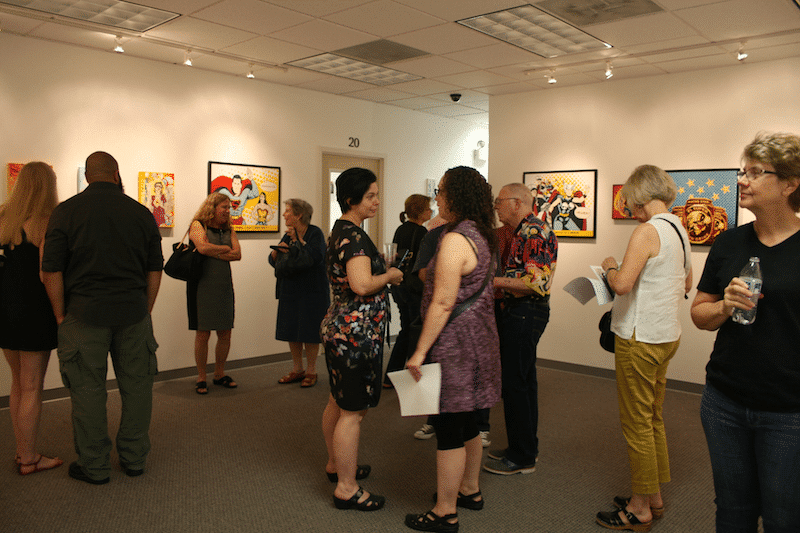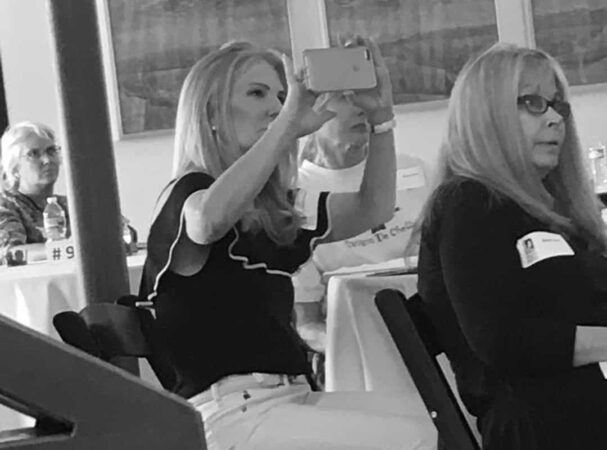I don’t call myself a writer. That’s because there’s a whole body of self-identified “writers” who dream, congregate, swap ideas, and hang out at open-mic nights, but don’t write. If you answer the question “Are you a writer?” with “Not this month, but I was last month and hope to be again soon,” that’s a recipe for perturbing the “writer” crowd.
The prevailing doctrine of writing culture is: if you have ever scribbled something on the back of a grocery sack, you’re a writer. If you wrote poetry in college, and a story once at a camp, you’re a writer. Okay, fine, but if they’re writers, I’m not that. I don’t want to be. I want to do the thing itself, not put the word on a mug.
Enter visual artists—the working ones, in particular. They don’t get a pass on the thing itself. What they do get is a set of conceptual tools that I find incredibly useful. Visual artists have a lot to teach literary ones.
Work or Die
Discovering the world of visual artists and how they live—the almost ascetic requirement to create or shut up—has only stoked my flame of dissent. It confirms that I’ve been right to take the more obstinate path of the “artist.” An artist can’t rest on his laurels because that means he won’t eat. An artist is only as good as his last act of creation. A 20-year kung-fu master who hasn’t practiced in seven years is junior to one who has practiced continually for 15. It’s like that with artists. You’ve never fully paid your dues.
Yes, visual art has its share of fakers, shirkers, and frauds, but while a writer can put “writer” under his name in the social-media venues where he spends all of his time avoiding the act he’s describing, an artist can’t go around “art-ing” something. He has to get specific. A sculptor sculpts. A painter paints. That means actually doing the work. It’s hard to make eye contact with someone who says “I’m a sculptor” but hasn’t produced anything in several years (with due respect to the retired).
More importantly, the lion’s share of visual artists who do the work consistently can’t conceive of not doing it. Clark Hulings said, “If you can imagine yourself doing anything else, go do it.” His message was, “Art is too hard a path to choose if you don’t need it that badly.” To say, “I’m a visual artist” is to bring down upon yourself a wave of skepticism and pity that you have to overcome just to function with self-respect.
Visual artists who don’t need to create art don’t stick around long. Those that endure, however, develop muscles that a lot of writers don’t—the main one being the ability to align actions with inner motivations. They learn to dig for what they want until they see it appear, quite literally from their hands.
Studio Time is Paramount
I no longer make art in my office. I make it in my studio. The room hasn’t changed, but its definition has. From visual artists, you immediately learn the solitary nature of the studio, the artist’s Fortress of Solitude, shutting out the world’s continual demands. It’s not just a place but a plane removed from the fray of distractions. As much as I think you’re only as good as what you’ve produced lately, the studio is also liberty from the tyranny of production. I used to fault myself every time I failed to generate the actual words, and even resorted to literary forms that lent themselves to filling up pages immediately.
For me, the goal is no longer “writing time” but, more broadly, studio time. Not time holding a brush, but time immersed in the entire creative process, which might mean sitting with feet propped up, wondering what a character’s “good” is (every character has a “good”).
Watching an artist “in situ”—orienting, composing, visualizing with a dry brush—becomes permission, in other words, to make what we really want. It might involve deciding on the aural backdrop of a character’s comfort zone (the sound that represents a character’s preferred reality—some are cicadas, others birds). It could take the form of pondering what a character hates about himself.
Besides not substituting art groups for the act of making art, we cannot substitute making art (in the literal sense of putting words to paper) for really making art—making all of it. So, unless that’s an excuse, it doesn’t take long to realize the need for a LOT more studio time, to carve out a world where one can go and truly pursue the entire creative process.
Outcome-Driven Process
Literary artists can be lured away into “process.” We tell ourselves that we need a certain kind of paper, notebook, ink, background music, or whatever. We risk becoming writers who have the fountain pen and the ideal coffee—brewed almost exclusively from our creative juices—but do not write. That’s the dark side of having a “process.”
Visual artists cut a little straighter to the bone. The process is typically outcome based. They don’t have to obsess about the small stuff because if they can’t buy something they need, they’ll probably make it.
We’ve all got a set of prerequisites. I need a big bottle of water, so I don’t have to leave the studio. I need to have meals already accounted for, instead of trying to figure it out when I get hungry. And I need to lock the door and shut out the noise of the world. If I can do those things, I’m pretty set.
On the creative process side, we diverge, but only in principle. At minimum, I need to see how the story “could” end, and I bet some painters do, too. I need to know if anything big, but not central to the plot, is going to interfere with the main character—like love. I need to put the information about setting, characters, etc. directly into the outline, instead of keeping it as separate notes. I simply can’t look in five places to know what’s happening in a scene. I need it to flow, to know where to manifest that reality.
Many visual artists compose in the same way. Unlike many of their literary brethren—who are locked into the form of the novel, short story, or screenplay, and the seminal examples that produced those forms—visual artists view the field as wide open. They think they have full license to do pretty much anything they want to the canvas or clay with a process that’s seriously weird or “unapproved” or previously unknown to them.
They can define their process based solely on what produces the desired outcome. In short, they can be all about the work.
Trial and Error
One of my favorite things about Clark Hulings is that he composed with layers. First, he’d paint on paper, then stack the pieces on his canvas, almost like a flipbook, trying different characters, colors, and placements until his compositions pleased him. In later years, he used Photoshop to speed up the process. No one, least of all the artist himself, questioned the “authenticity” or idiosyncrasy of his process. The work is a result of that process, and the work is unquestionably best in class.
In light of this, I’ve started trying out scenes with my characters without worrying about whether I’ll ultimately keep or lose those scenes. The tension of having to get it right has evaporated. For any given “right,” I now allow myself as many wrongs as I want. Indeed, the wrongs are integral.
I suspect the painters’ myth for public consumption is a lot like it is for literary artists. We’re supposed to be able to just walk up to the canvas and do it. Maybe we make an outline or something, but surely we don’t make hundreds of components that are either kept or discarded. Even if some painters do just throw oil at a canvas, Clark freed me from considering robust measures of composition to be the province of the hack; they’re actually part of being a pro.
The visual artist is the closest thing in the modern world to the “inventor” of the late industrial era. An inventor might create any number of brilliant failures before developing the Flubber or Chitty Chitty Bang Bang of the old black-and-white movies. Asked how it felt to fail 10,000 times on the way to the light bulb, Edison famously said, “I have not failed. I have discovered 10,000 things that don’t work.” The willingness to keep trying and trying until they to get the outcome they desire is perhaps my favorite visual artist’s trait, and it’s virtually a requirement unless one is wholly derivative.
As an educator, I share my expertise with visual artists—in sales and marketing, business and community organizing—but I don’t do this work solely because I believe I have much to teach them. I also do it because they have much to teach me. Part of my “soft compensation” is that I get to apply what I’ve learned from the world of their myriad creative Fantasia factories to my world of literary arts, giving me fresh eyes on my core craft of storytelling.







Daniel, this is the best wording about an artist’s journey that I’ve ever read. You have put much meaning into our time, whether feet propped up mentally composing, alone time in the studio, or brushes (in my case, pastel) whispering on the paper. Painting and all that goes with it equates to everyone. Thank you for being with CHF.